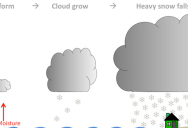This Is How Lake-Effect Snow Works
If you’ve ever lived anywhere in the Great Lakes region, you know that winter can be ROUGH.
Lots of wind, lots of below-freezing temperatures, and TONS of SNOW.
And if you’ve called those areas home at any time in your life, chances are that you’ve heard the term “lake-effect” snow before.
But what does it mean, exactly, and how does lake-effect snow work?

Photo Credit: Unsplash,Shawn Dearn
Well, the first thing you obviously need is a lake and Lake Erie is in the news a lot when places like Buffalo, New York, get feet of snow dumped on them.
A body of water such as Lake Erie will have a temperature difference between the actual lake and the air above it. The water in the lake warms and cools slower than the air above it. The lake will be heated by the sun all summer long and therefore will stay warm long into the fall months.
When the cool air is above the lake water, moisture from the lake evaporates and the air above the surface warms up. The air rises and condenses, forming heavy clouds.
The “lapse rate” is the rate of change in temperature as you go higher up into the atmosphere. The higher the lapse rate, the more unstable the system is, and, in turn, you get a greater chance of a weather event.

Photo Credit: Unsplash,Ken Whytock
When a system reaches shore, more friction makes the wind slow down, causing clouds to pile up and hills, mountains, and other topography pushes the air even higher, which causes more cooling and more condensation.
The specific lake and the orientation of how the wind blows there will affect lake-effect snow. The greater the area of water the wind blows across before it gets to shore, the more extreme the storm.
Here’s a handy graphic on how all of that works!

Photo Credit: National Weather Service
The southern and eastern shores of America’s Great Lakes usually get hit the hardest by lake-effect snow because the winds gather momentum and come down from the northwest.
Let’s all keep our fingers crossed that this winter won’t be too bad for the folks who live near the Great Lakes and that they don’t spend the cold months digging themselves out from constant snowstorms!

Sign up to get our BEST stories of the week straight to your inbox.




